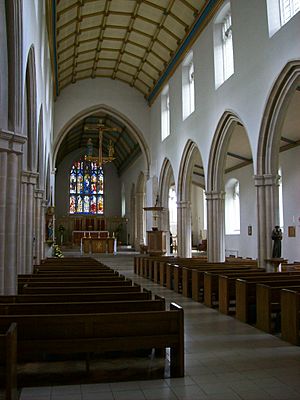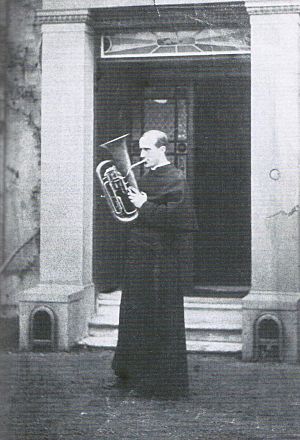St Mary and All Saints, Little Walsingham facts for kids
St Mary and All Saints Church is a special church in a village called Little Walsingham in Norfolk, England. It's named after the Virgin Mary and All Saints. Walsingham used to be famous for a very old shrine dedicated to Our Lady of Walsingham, but it was destroyed a long time ago. Later, in 1922, a vicar named Alfred Hope Patten helped bring the shrine back to life. The statue of Our Lady of Walsingham was first kept in this church before moving to a new building in 1931.
Contents
About the Church Building
This church was built a long time ago, in the 1300s and 1400s. It's made from flint stone. The church has a main area (nave), a chancel (where the altar is), and side sections called aisles and transepts. There's also a tall tower at the west end with a lead spire.
Sadly, in 1961, a big fire badly damaged the church. Only the tower and the north porch were left from the original building. The rest of the church had to be rebuilt. It's considered a very important historical building, known as a Grade I listed building. Even the churchyard walls and gates are listed as Grade II.
When Fr Patten became the vicar in 1921, he changed the church's name from just "All Saints" to "St Mary and All Saints."
Inside the church, you can find several memorials. One of the most detailed memorials is for Henry Sydney (who lived from 1553 to 1612) and his wife Jane (1565-1638). There's also a large memorial for the Lee-Warner family in the north transept. This family owned the land where the old priory used to be.
The church is famous for its font, which is a stone basin used for baptisms. This font is from the 1400s and shows pictures of the Seven Sacraments and the Crucifixion. Luckily, the font survived the 1961 fire! The font's cover, from the 1600s, was destroyed, but a new one was made in 1964 to look just like the old one. There's even a painting of this font by the artist William James Müller at the Birmingham Art Gallery.
Organs and a Big Bang in 1866
In 1862, an organ was put into the church. This meant the church's band, which used to play music, was no longer needed. The band's leader, Miles Brown, was not happy about this.
Four years later, on Bonfire Night in 1866, something "remarkable" happened. Just after the 8 pm bell rang, there was an explosion in the south transept! Someone had put gunpowder under the organ and lit it. Most of the organ was blown to pieces, and the window in that part of the church was completely destroyed. Miles Brown was never officially charged for the explosion. The story of Brown destroying the organ was even made into a play called The Walsingham Organ in 2002.
The organ that was blown up was built by Mark Noble. It wasn't replaced right away. The next vicar, George Ratcliffe Woodward, was a great musician. He used to play the euphonium (a brass instrument) during church processions, which suggests there wasn't an organ for a while. A new organ was finally installed in 1890 by Thomas Casson. This organ was still in the church when the 1961 fire happened and was also destroyed.
Fr Hope Patten and the Shrine's Return
The church started to see changes in the 1880s with something called the Catholic Revival in the Church of England. This was a movement to bring back older, more traditional church practices. When Fr Woodward became vicar in 1882, he started celebrating Holy Communion every week instead of every two weeks. He also introduced a robed choir, traditional singing, special clothes for services (vestments), lighted candles, and more frequent Holy Communion.
Later, during Fr Edgar Reeves' time as vicar (1904-1920), incense was used, and a statue of Our Lady was brought in. By 1919, the church was known as "the famous pilgrimage church of our Lady."
Alfred Hope Patten was born in 1885. He was very keen on Anglo-Catholicism, which is a part of the Church of England that keeps many Catholic traditions. He believed it was important to bring back old traditions that were stopped during the Reformation. One of these was the devotion to Our Lady of Walsingham.
On July 6, 1922, with a big ceremony and ringing bells, a new copy of the old statue of Our Lady of Walsingham was shown in a side chapel. It was carried in a procession past the famous font.
The first big pilgrimage happened the next year, in 1923. It started in London and ended at Walsingham.
The Bishop of Norwich, Bertram Pollock, wasn't happy about the growing devotion to Mary. In 1930, he told Fr Patten to remove the statue from the church. But Fr Patten didn't give up! With help from a supporter, he bought some land in the village that wasn't owned by the Church of England. This meant the bishop couldn't control what happened there. On this land, Fr Patten built a new "Holy House," which was a copy of the original shrine destroyed by Henry VIII.
The statue was moved to this new shrine on October 15, 1931. There was a large procession, about half a mile long, carrying the statue to its new home.
Fr Patten passed away on August 11, 1958. He is buried in the churchyard of St Mary and All Saints.
The 1961 Fire and Rebuilding
On July 14, 1961, the church was destroyed by fire, probably set on purpose. The porch and the tower, including its spire, survived. The church was rebuilt by Laurence King using a type of stone called Ancaster stone.
Luckily, the church's special silver and gold items (church plate) were saved, as was Fr Reeves' statue of Our Lady. But almost everything else was lost. The vicar at the time, Fr Roe, asked for donations of church items like robes and hymn books to help rebuild.
During the rebuilding, the south transept was made into a chapel for St Catherine. This is the same name as a chapel in Houghton Saint Giles where old pilgrims used to stop, take off their shoes, and walk the last mile to Walsingham barefoot. The north transept became the Guilds' Chapel, named after groups who had built a chapel there in the 1500s. This chapel has a beautiful altarpiece by George Frederick Bodley showing the Virgin Mary and baby Jesus with angels.
Most of the stained glass windows were lost in the fire. For the large east window, a modern design was chosen by John Hayward. It uses some pieces of the old glass that survived. This window tells the story of the Holy Trinity, shows all the saints who have altars in the church, and has an image of Our Lady of Walsingham. It also tells the story of the Shrine and the church. The windows in the porch, from 1890, survived the fire and show the Annunciation (when the angel told Mary she would have Jesus).
A new organ was also built for the restored church by Cedric Arnold, Williamson & Hyatt.
Church Bells
The church has a set of six bells. Some of them are very old, cast in 1569 and 1675. Two more were made in 1691, and the newest bell was added in 1987. The five older bells survived the 1961 fire. They were taken down in 1985 when a new frame was built and then put back up in 1987.
The Parish
St Mary and All Saints Church is part of a larger group of churches called a parish. It's joined with St Peter's Church in Great Walsingham and St Giles' in Houghton Saint Giles. Nearby, the parish of Barsham includes three other churches. Together, these parishes form the Benefice of Walsingham, Houghton and Barsham.
The Sanctuary School
From 1944 to 1956, the church ran a private school called the Sanctuary School. It was a preparatory school for boys. The school originally started in London in 1897. During World War II, a branch of the school was set up to keep boys safe from bombing in London. In 1944, the school moved to Walsingham. The vicarage (the vicar's house) became the boarding house for the boys.
The school had several headmasters. Some of the teachers included Albert Peatfield, who was a famous cricket player. Some students from the school went on to do important things, like Tony Hall-Matthews, who became a bishop in Australia.
Church Leaders (Clergy)
It can be a bit tricky to find out about the very early church leaders. Here are some of the vicars who have served at St Mary and All Saints Church:
- James Lee-Warner, 1807-1834
- James Lee-Warner, 1834–1859 (son of the above)
- Septimus Henry Lee-Warner, 1859–1870 (cousin of the above)
- William Martin, 1871-1882
- George Ratcliffe Woodward, 1882–1888. He was a musician who wrote famous carols like This joyful Eastertide and Ding Dong Merrily on High.
- Henry Arthur Wansbrough, 1889–1904.
- Edgar Lee Reeves, 1904–1920. He was fined for ringing the church bells two days early to celebrate the end of World War I in 1918.
- Alfred Hope Patten, 1921-1958. He was the vicar who helped bring back the Shrine of Our Lady of Walsingham.
- Alan Arthur Roe, 1958–1977. He was the vicar who rebuilt the church after the 1961 fire.
- John Edgar Barnes, 1977–1989. He later became a Catholic priest.
- Michael John Rear, 1989–1995. He also later became a Catholic priest.
- Keith Frank Michael Haydon, 1995-1999
- Norman Banks, 2000–2012. He later became a bishop.
- Andrew Mark Mitcham, 2013–2018.
- Harri Alan McClelland Williams, 2018-present




